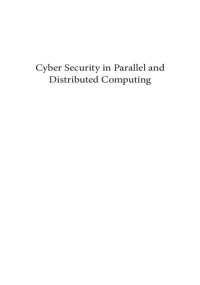
Ebook: Cyber Security in Parallel and Distributed Computing
- Year: 2019
- Publisher: Scrivener Publishing
- Language: English
- pdf
Today cybersecurity is one of the prime concerns for any organization,
whether governmental or private sector; and for the sake of security and safety,
it may be considered of national importance for a country. Many components
of cyberspace are disreputable and therefore vulnerable to an expanding range
of attacks by a spectrum of hackers, criminals, terrorists, and state actors. For
example, both government agencies as well as private sector companies, irrespec-
tive of their size and nature, may suff er from cyber theft s, cyber vandalism and
attacks like denial-of-service or other service-related attacks, since they incor-
porate sensitive information. Many of a nation’s critical infrastructures, like the
electric power grid, air traffi c control system, fi nancial systems, and communica-
tion networks, depend extensively on information technology for their opera-
tion. Nowadays, threats posed by the vulnerabilities of information technology
and its malicious use have increased along with technological advancements.
Following the infamous September 11, 2001 attacks against the United States,
the importance of maintaining a properly fashioned security environment has
been realized in light of increased cyber espionage directed at private companies
and government agencies. National policy makers have become increasingly con-
cerned that adversaries backed by considerable resources will attempt to exploit
cyber vulnerabilities in the critical infrastructure, thereby infl icting substantial
harm on a nation.
Numerous policy proposals have been suggested in the past and a number of
bills have been introduced to tackle the challenges of cybersecurity. Although the
larger public discourse sometimes treats the topic of cybersecurity as a new one,
the Computer Science and Telecommunications Board (CSTB) of the National
Research Council has extensively recognized cybersecurity as being a major chal-
lenge for public policy. Th erefore, for over more than two decades the CSTB has
off ered a wealth of information on practical measures, technical and nontechnical
challenges, as well as potential policy concerning cybersecurity. Drawing on past
insights developed in the body of work of the CSTB, a committee has produced a report entitled Cybersecurity Primer: Leveraging Two Decades of National Academies
Work, which acts as a concise primer on the fundamentals of cybersecurity and the
nexus between cybersecurity and public policy.
Th e main objective of this book is to explore the concept of cybersecurity in paral-
lel and distributed computing along with recent research developments in the fi eld.
Also included are various real-time/offl ine applications and case studies in the
fi elds of engineering and computer science and the modern tools and technologies
used. Information concerning various topics relating to cybersecurity technologies
is organized within the sixteen chapters of this book.
whether governmental or private sector; and for the sake of security and safety,
it may be considered of national importance for a country. Many components
of cyberspace are disreputable and therefore vulnerable to an expanding range
of attacks by a spectrum of hackers, criminals, terrorists, and state actors. For
example, both government agencies as well as private sector companies, irrespec-
tive of their size and nature, may suff er from cyber theft s, cyber vandalism and
attacks like denial-of-service or other service-related attacks, since they incor-
porate sensitive information. Many of a nation’s critical infrastructures, like the
electric power grid, air traffi c control system, fi nancial systems, and communica-
tion networks, depend extensively on information technology for their opera-
tion. Nowadays, threats posed by the vulnerabilities of information technology
and its malicious use have increased along with technological advancements.
Following the infamous September 11, 2001 attacks against the United States,
the importance of maintaining a properly fashioned security environment has
been realized in light of increased cyber espionage directed at private companies
and government agencies. National policy makers have become increasingly con-
cerned that adversaries backed by considerable resources will attempt to exploit
cyber vulnerabilities in the critical infrastructure, thereby infl icting substantial
harm on a nation.
Numerous policy proposals have been suggested in the past and a number of
bills have been introduced to tackle the challenges of cybersecurity. Although the
larger public discourse sometimes treats the topic of cybersecurity as a new one,
the Computer Science and Telecommunications Board (CSTB) of the National
Research Council has extensively recognized cybersecurity as being a major chal-
lenge for public policy. Th erefore, for over more than two decades the CSTB has
off ered a wealth of information on practical measures, technical and nontechnical
challenges, as well as potential policy concerning cybersecurity. Drawing on past
insights developed in the body of work of the CSTB, a committee has produced a report entitled Cybersecurity Primer: Leveraging Two Decades of National Academies
Work, which acts as a concise primer on the fundamentals of cybersecurity and the
nexus between cybersecurity and public policy.
Th e main objective of this book is to explore the concept of cybersecurity in paral-
lel and distributed computing along with recent research developments in the fi eld.
Also included are various real-time/offl ine applications and case studies in the
fi elds of engineering and computer science and the modern tools and technologies
used. Information concerning various topics relating to cybersecurity technologies
is organized within the sixteen chapters of this book.
Download the book Cyber Security in Parallel and Distributed Computing for free or read online
Continue reading on any device:

Last viewed books
Related books
{related-news}
Comments (0)